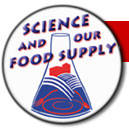|


Dr. Theobald Smith
(1859-1934)
|
In the late 1800s, Dr. Theobald Smith, a researcher under Dr. Daniel E. Salmon
in the USDA's Bureau of Animal Industry, was the first American to identify Salmonella
as a separate strain or genus.
Although Smith actually identified the bacteria, Salmon's name as administrator
was listed first on the research paper, so the new bacterium was named for Salmon.
|
|
Salmonella Muenchen is a rare species of Salmonella that
doesn.t show up in the general population very often. Beginning in late June 1999,
this bacterium caused an outbreak that involved a total of 423 illnesses in 22
states and 3 Canadian provinces.
Salmonella was found, for the first time, in unpasteurized juice. This
outbreak resulted in a nationwide recall of the unpasteurized juice.
|
|
List of Terms: S
(Return to Comprehensive List of Terms)
> Salmonella
A group of bacteria that can cause diarrheal illness in people.
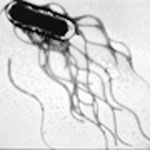
Salmonella
Sources: Raw and undercooked eggs, raw meat, poultry, seafood, raw milk,
dairy products, and produce.
Illness
Incubation: 12 to 72 hours after eating contaminated food.
Symptoms: Diarrhea, fever, and abdominal cramps. Symptoms can be more
severe and cause death among people in the at-risk groups.
Duration: 4 to 7 days.
More on Salmonella Enteritidis and Salmonella Typhimurium:
- There are approximately 2,000 different serotypes of Salmonella bacteria.
Salmonella serotype Typhimurium and Salmonella serotype Enteritidis
are the most common in the United States.
- Most types of Salmonella live in the intestinal tracts of animals and
birds and are transmitted to humans by contaminated foods of animal origin. Salmonella
Enteritidis can silently infect the ovaries of healthy-appearing hens and contaminate
the eggs before the shells are formed (also see Competitive
Exclusion).
- Salmonella Typhimurium DT104 is an emerging pathogen and a highly virulent
strain of Salmonella that is resistant to several antibiotics. This organism
is now the second most prevalent strain of Salmonella after Salmonella
serotype Enteritidis.
> Sample
A specimen that is taken from food and tested for the purpose of identifying a
foodborne pathogen or various kinds of chemical contaminants in food.

How is a sample different from an isolate?
Samples are food, whereas isolates are bacteria that have been taken from a
food or a patient (e.g. clinical isolate). A sample could be some of the
suspected food or all the food that's left after a foodborne outbreak. During
an outbreak, microbiologists try to isolate the pathogen from the sample or food
in order to identify it. (Also see Food
Isolate.)
|
> Sanitation
The act of maintaining a clean condition in a food-handling situation in order
to prevent disease and other potentially harmful contaminants.
|
|

| You can use one teaspoon of liquid chlorine bleach per quart of clean water
to sanitize surfaces. The bleach solution needs to sit on the surface to
be sanitized for about 10 minutes to be effective. Note: Don't wash raw
produce with soap, detergents, or bleach solutions. Rinse raw produce under running
water. |
|
> Sanitizer
Chemical or physical agents that reduce microorganism contamination levels present
on inanimate environmental surfaces.
Food Safety Implication: Using hot, soapy water is sufficient for cleaning
food-contact surfaces, cutting boards, utensils, etc. Periodically, kitchen sanitizers
can be used for added protection against bacteria. Sanitizers help kill bacteria,
so that bacteria doesn't spread to food.
Two Classes of Sanitizers:
- Sanitizers of Non-Food Contact Surfaces - Traditionally, the performance
standard used by the Environmental Protection Agency (EPA) for these sanitizers
has required a reduction of the target microorganism by 99.9% or 3 logs (1000,
1/1000, or 103) after 5 minutes of contact time.
- Sanitizing Rinses for Previously Cleaned Food-Contact Surfaces - Traditionally,
the EPA performance standard for these sanitizers has required a 99.999% or 5-log
(105) reduction of the target microorganism in 30 seconds. (See Log
Reduction.)
Disinfectants: In comparison, disinfectants come in a variety of categories
and are also agents that help eliminate undesirable microorganisms from inanimate
environmental surfaces. Because these surfaces are inanimate, they are considered
contaminated, not infected. Measurement of disinfectant performance varies by
product type (spray, dilution product, impregnated wipe, etc.).
Disinfectant performance is typically not defined in terms of a specific percentage
or log-reduction target, and unlike the sanitizers for food-contact surfaces,
products that are termed disinfectants are usually not intended for use in association
with food-contact surfaces.
Note: Read and follow label directions to determine the specific microorganism
a product kills and how to use the product effectively. Sanitizers and disinfectants
must remain in contact with a surface for a specified period of time in order
to kill organisms. Be sure to check the label.
> Satellite Tracking (also known as Satellite
Monitoring)
Equipment that automatically records refrigeration system functions and the air
temperature inside refrigerated containers that transport foods across the country.
This information provides a detailed record of the refrigeration system's performance
during the trip.
Food Safety Implication: To avoid the risk of food spoilage and microbial
growth during shipment, satellite tracking monitors the temperature inside refrigerated
containers.
> "Sell By" Date
A calendar date on the packaging of a food product that indicates the last day
the product can be sold.
The "sell by" date tells the retailer how long to display a product. It guides
the rotation of shelf stock and allows time for the product to be stored and used
at home. The date is quality driven, not a food safety concern. (Also see "Best
If Used By," Expiration, and "Use
By" Dates.)
> Serogroup
A sub-species classification system that uses serum (the clear, yellowish liquid
that separates from the clot when blood coagulates) from immunized animals to
distinguish between bacterial isolates that belong to the same genus and species.
Food Safety Implication: For outbreak analysis, serotyping serves as
a fast, easy method for classifying bacterial isolates for the purpose of comparing
strains recovered from foods, patients, and the environment. It also helps epidemiologists
determine if a foodborne illness is an isolated occurrence or part of an outbreak.
How It Works: Each bacterial strain elicits a specific immune response
when it is introduced into an animal. A bacterium expresses specific proteins
and carbohydrates on its surface to which antibodies may react.
Public health scientists have assembled a specific set of antibodies that react
with certain bacteria. The profile of which serum/ sera the bacterial isolate
reacts with is called its serogroup or serotype. Groups of bacteria that react
to a certain antibody are considered to be members of that serogroup.

Why can shelf-stable foods be stored on the shelf at room temperature?
There are numerous techniques that make some foods shelf stable. The primary technique is to lower the water content of the food (some foods, like flour, are naturally low in water). Bacteria need water to grow and if there isn't enough water present, then the bacteria will not grow.
Foods can also be acidified. (See Acidification.) Or, food can be heated to ultra-high temperatures, so that it becomes sterile. Some irradiation treatments work in this manner. Once the food is made sterile, however, it has to be hermetically sealed (airtight). If not, the food can become recontaminated and pathogens and other bacteria can grow quickly.
How long can shelf-stable foods be safely stored on the shelf?
According to the Food and Drug Administration (FDA), food can be safe forever from a foodborne-illness standpoint - but if shelf-stable food has been on the shelf for an extended period of time, you might not want to eat it because the quality may not be good. In this case, the "best if used by" date on the label of the product is an indication whether or not the quality of the food is good. Food quality deals with the taste, texture, and nutritional value of food. For example, freezer burn, rancidity, and food spoilage are all quality-related issues. The FDA does not require an expiration date for shelf-stable foods, since the storage time for these foods is a quality issue, not a food safety concern.
|
> Shelf Stable
A food that is able to be stored un-refrigerated on the shelf for a period of
time and remain suitable for consumption.
Food Safety Implication: Many foods are processed and packaged for food
safety and preservation purposes. In order for food to be considered shelf stable,
the various techniques used should inhibit microorganisms from growing in the
product at non-refrigerated temperatures of storage (extended periods over 41°
F [4° C]).
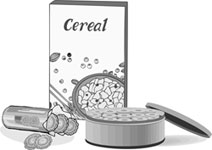
An Example of Shelf-Stable Foods
Some Shelf-Stable Foods Include:
- Canned vegetables,
- Cookies fruits, and juices
- Crackers
- Canned meat
- Nuts
- Cereals
- Raisins
|
|

| Shigella outbreaks are usually caused by an ill food worker
who, after using the bathroom, does not practice safe handwashing techniques and
subsequently touches food with his or her hands. |
|
> Shigella
This bacterium is carried only by humans and causes an estimated 448,420 cases
of diarrheal illnesses in the United States per year. Poor hygiene, especially
improper handwashing, causes Shigella to be easily passed from person to
person via food. Once the bacterium is in the food, it multiplies rapidly at room
temperature.
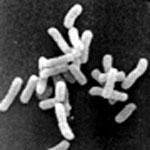
Shigella
Sources: Salads, milk and dairy products, raw oysters, ground beef,
poultry, and unclean water.
Illness
Incubation: 1 to 7 days after eating contaminated food.
Symptoms: Diarrhea, fever, abdominal cramps, vomiting, and bloody stools.
Duration: 5 to 7 days.
> Species
A group of organisms that are genetically related. The second word in the binomial
name of a bacterium is called the species name. (Also see Binomial
Nomenclature and Genus.)

If spores can survive cooking, freezing, and some sanitizing measures, how can spores be prevented from the start?
Conquering spores is not an easy process because spore growth can occur anywhere. There are food safety precautions you can take. Do not hold food in the danger zone, the temperature range in which most bacteria can grow. This range is usually below 40° F (4° C). Some pathogenic bacteria can grow at 32° F (0° C) or above 140° F (60° C). Spores can germinate into pathogenic bacteria in the danger zone and multiply in food. For example, any cooked dish will generally have all the bacteria killed, but not the spores. When in doubt, throw the food out! (Also see Danger Zone.)
Spore growth is also relevant to improperly canned foods. The Food and Drug Administration (FDA) makes sure that canned foods are processed in a safe manner. Consumers should be careful not to buy cans with dents, bulges, leaks, or rust spots. A failure in the canning process can allow spores to generate gas and germinate into pathogenic bacteria. (Also see Canning.)
|
> Spore
A thick-walled protective structure produced by certain bacteria and fungi to
protect their cells.
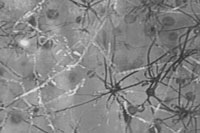
Spores like these are found everywhere
in the environment, including in foods.
Food Safety Implication: Some spores can germinate into pathogenic bacteria,
such as the highly potent Clostridium botulinum, which is primarily a threat
in improperly canned foods and can cause botulism. Other spore-forming pathogens
include Clostridium perfringens and Bacillus cereus. These pathogenic
bacteria can cause foodborne illness when the contaminated food is eaten.
In addition, some spores often survive cooking, freezing, and some sanitizing
measures. For example, the spores of certain bacteria can survive boiling for
6 hours. When conditions are favorable for bacterial growth, the spore will germinate
and the bacterial cell will divide.
|
|

| Staphylococcus can produce toxins that are not destroyed
by high cooking temperatures. To prevent toxins from developing in food, don't
leave food sitting out at room temperature for more than 2 hours. |
|
> Staphylococcus aureus
This bacterium is carried on the skin and in nasal passages of humans and often found in infected cuts and burns. These wounds should always be covered with a water-proof bandage or plastic gloves to avoid contact with food. Staphylococcus aureus produces
a toxin that causes vomiting in as little as 30 minutes after ingestion. It also
multiplies rapidly in food that's left out at room temperature.
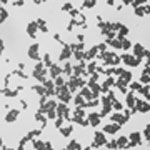
Staphylococcus aureus
Sources: Dairy products, salads, cream-filled pastries and other desserts,
high-protein foods, such as cooked ham, raw meat and poultry, and humans (skin,
infected cuts, pimples, noses, and throats).
Illness
Incubation: Usually rapid - within 30 minutes to 8 hours after eating
contaminated food.
Symptoms: Nausea, abdominal cramps, vomiting, and diarrhea.
Duration: 24 to 48 hours.
> Strain
A variant of a species of bacteria. Some may be pathogenic and some may be benign.
For example, most E. coli are neutral or helpful to people, but E. coli
O157:H7 is a strain of E. coli that is harmful to people.
> Surveillance
A system of monitoring the health of the population, which is used to prevent
food-borne illness outbreaks from increasing.
Food Safety Implication: By monitoring the health of the population,
foodborne illness can be reduced by recognizing outbreaks and responding to them.
This can be done by determining the source, eliminating the source, and preventing
the spread of illness by infected individuals.
> Survey
A tool used by epidemiologists to understand the state of health of the population
or to identify the source of a foodborne outbreak.
Food Safety Implication: Epidemiologists actively "survey" (seek out)
individuals to see if they are sick or well. If people are suspected of being
sick from food, then epidemiologists will survey sick and well people to determine
what they ate. The results of the survey should implicate a specific food, location,
or time of consumption.
|
